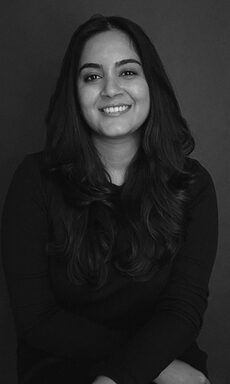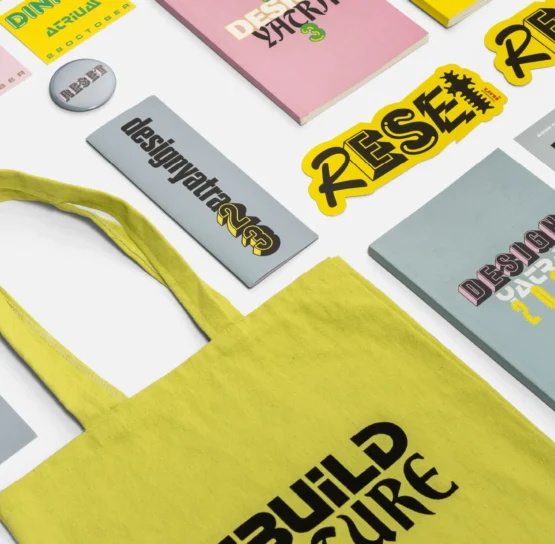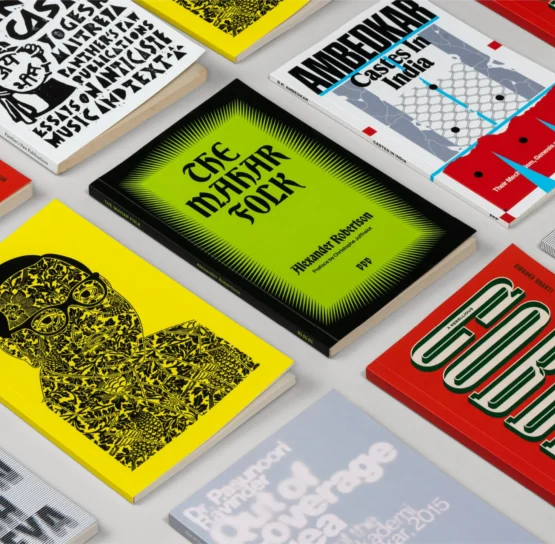Juhi Vishnani
Juhi Vishnani, graphic designer, creative director, and co-founder of November, brings a research-driven approach to identity systems, publications, and brand strategies, blending India's rich archival heritage with contemporary design to redefine visual culture.
A graphic designer, creative director, and co-founder of the plural design studio November, Juhi Vishnani's works stand out for her conceptual foundation, taking strong inspiration from India’s rich archival elements and visual culture. With a deeply research-driven approach, Juhi has spearheaded identity systems, publications, packaging, and brand strategies for both commercial and cause-driven projects. Through her works November has made a significant impact on the design landscape, establishing it as one of the foremost studios in India’s graphic design space today. Some of Juhi’s most notable works include creating plural identity systems for Design Yatra 2023—a large-scale project requiring extensive work across print and digital media—and designing the logo for the print and digital publication Dirty Magazine. Another notable aspect of some of Juhi's works is her ability to break away from convention and forge a design language that feels unmistakably Indian. While acknowledging the influence of Western aesthetic codes in Indian design, what truly sets her works apart is viewing this exposure as a chance to merge it with India's rich graphic and visual heritage. Some of her earliest works also reflect this for instance her lettering for Design Across Borders explores the concept of "home" through the Arabi-Sindhi word ghar, a nod to her Sindhi heritage. A graduate with an MA in Graphic Design Communication from UAL, London, Juhi Vishnani’s career has steadily evolved over the years. Since the beginning of her career, Juhi has worked at different agencies across a diverse range of industries including FMCG, hospitality, and finance. Beyond her role as the bridge between conceptualising ideas and tangible outcomes, Juhi also delves into hands-on material processes. An example of this can be seen in her work with linocuts for Panther Paw’s publication. At November, Juhi, alongside her partner and co-founder Shiva Nallaperumal, led projects for an impressive and diverse client roster, including Apple Music, Uber, Nicobar, Bodice, Eka, Kyoorius, the Indian Institute of Architects, Ensemble, British Council and Kobe Bryant. Her works exemplify the rising wave of Indian creatives redefining brand identity—not merely as service providers but as active collaborators, reshaping the language of design in modern India.



Juhi speaks to Blur The Border :
Blur : Your experience at TSK and Landor likely offered valuable insights into design on a big scale. What drove you to branch out on your own, and how did those experiences influence your vision for your independent practice?
Juhi : Starting our own design practice was always the end goal, but I wanted to gain some solid work experience before diving in. My time at TSK and Landor definitely taught me a lot—both what to do and what not to do. From handling presentations and juggling multiple projects to the basics like file management, I learned a bit of everything. But when we started November, the real learning began. It wasn’t just about applying what I’d learned before—it was about figuring things out as we went. Through November, we learned so much. No one teaches you how to value your work monetarily, how to manage teams, or how to delegate. We made mistakes early on, like not having contracts in place or failing to record meetings and take notes. But we’ve grown from those mistakes and refined our process over time.
Blur : You have spoken against the dogma of design as purely problem-solving. How do you define the purpose of design in your practice?
Juhi : Not everything needs a ‘solution.’ Sometimes, it’s just about creating something fun or leaving a lasting impression. Other times, it’s about celebrating aspects that already exist but go unnoticed. While problem-solving is undoubtedly an important part of design, I find it limiting to define it as the central focus.
I really admire Japanese design: I’ve found it’s much more emotion-driven, joy-driven—focused on creating experiences and objects that connect with people on a deeper, often subtler level. Take Naoto Fukasawa’s design for this mobile phone, inspired by his memory of peeling potatoes with his mother as a child—it wasn’t about solving a problem but evoking a sense of familiarity and comfort, celebrating the everyday.
My definition of design has evolved along these lines. A few years ago, I would’ve said design is about creating meaning, sparking curiosity, or making people feel something—and while those still hold true, I now see design as storytelling. It’s about the ideas, the people, the emotions, and the culture that brings it all together.
Blur : You describe yourself as practical and orderly in life but prefer a more intuitive approach to your work. How does this balance shape your creative process? Do you have any specific process, habits, or rituals that help you get into a creative mindset?
Juhi : I find myself craving consistency a lot, but I’ve realised I don’t have a fixed ritual—it really depends on the project. Sometimes it’s about rewriting the brief in my own words to understand it better, and other times it’s just talking things through with my partner. We discuss a lot, and if I ever feel stuck, I cook—it always helps me clear my head. One thing I can’t do is work in silence. I always need something in the background, whether it’s music or the TV. It makes the process feel less rigid. That said, the chaos of the past few years—multiple moves: we’ve lived in Goa, Chennai, Mumbai, The US—meant no real routine, both in work and life. Now that we’ve settled in Bombay, we’re focusing on bringing more consistency to our daily routine. We’re trying to build structure into our day with set working hours and boundaries, which helps in creating some balance. It’s an ongoing process, but we’re hoping that this new rhythm will help us stay grounded in our personal and work lives.
Blur : How does the environment impact your work and fuel your creativity?
Juhi : A lot of my thinking happens when I observe people—their behaviours, how they move, what they care about, and why they do the things they do. I bring a lot of these insights into my work, often in subtle ways. I believe, as Frank Chimero said, ‘People ignore design that ignores people.’ Empathy plays a huge role in our process—understanding human behaviours, cognitive processes, and the semiotics of how people interpret things is key to creating meaningful work. While I’m a big fan of neat and organised environments, I’ve learned that I’m actually pretty comfortable working anywhere. I don’t necessarily need a table and chair; as long as the space is conducive to thinking, I can work in almost any environment. For me, it’s about the mental space to create, not just the physical space.
Blur : How do you manage the balance between the creative and practical sides of being a professional artist?
Juhi : Fortunately for me, both sides coexist pretty naturally—I don’t find myself leaning too heavily towards one or the other. Honestly, I don’t even see a clear line between the two. We take on pro bono projects with the same level of commitment and enthusiasm as commercial ones. Often, the fun, exploratory work we do ends up leading to commercial opportunities anyway. We’ve built a practice that gives us the freedom to explore all facets of design, whether it’s purely creative, problem-solving, or something in between. That balance feels very organic to how we work.
Blur : How has your artistic style evolved over the years and how do you view this evolution?
Juhi : Over the years, I’ve become a lot more patient, and that’s reflected in the way I approach projects. When I was younger, my focus was on developing skills—learning the craft, honing the technical aspects, and getting better at what I do. That foundation now allows me to be a creative director, guiding and directing a team and collaborating with people who are practising skills I’ve experienced myself.
Now, my focus has shifted to the bigger picture. I’m more passionate about understanding the cultural context of a project and thinking about the longevity of a design solution—how it fits into its environment and how it will evolve over time. It’s about creating something that isn’t just trendy but something that will endure and have lasting impact. I also enjoy collaborating with other key stakeholders—architects, founders, and specialists—bringing in diverse perspectives to create work that feels meaningful and lasting.
My interests have also evolved over time. Right now, I’m exploring type design—a space I used to shy away from because it felt too slow and meticulous. But now, I find myself enjoying the meditative nature of the process and appreciating the depth it brings to my work.
Blur : Indian design, as you’ve mentioned, has been deeply influenced by modernism and Western ideals. What steps can the broader Indian design industry—schools, studios, and professionals—take to create a more distinct, locally grounded identity?
Juhi : Being influenced by the West was pretty inevitable, especially given our history and the cultural exchanges over time. But the bigger issue, I think, is the lack of documentation of all the amazing work that’s been created in India. So many artists and designers have shaped our visual culture, but their contributions are often overlooked or not credited enough. I’m not as interested in how Swiss design looks compared to Japanese design; I’m more curious about the cultural attitudes behind them. For example, Swiss design’s clean, neutral style mirrors Switzerland's political and cultural neutrality: it's natural that a typeface like Helvetica would come from there. On the other hand, Japanese design is more emotion-driven, focused on connection—and that reflects their cultural values: you can see it in design, furniture, stationary, anime, cinema etc. Design today has become so curated—what we like to call the "Pinterestisation" of design. Inspiration doesn’t come from hunting it down; it comes when you’re genuinely curious about the world and let yourself be surprised by it. In our work, we make it a point to stay grounded and take note of what’s around us—whether it’s the everyday design on the streets, in markets, or through the objects people interact with. These things naturally influence our thinking and our process. We don’t shy away from them, and that’s how we stay true to who we are and where we come from.
Blur : If you could collaborate with artists from other disciplines, is there a particular collaboration you would love to pursue?
Juhi : I’ve been fortunate to collaborate with artists from a variety of disciplines—photographers, writers, animators, stylists, and architects. But if I had to pick, I’d love to work with people who create objects, like furniture designers or ceramists. Handcrafted work has always fascinated me—the thought, precision, and effort that go into creating something tangible and timeless is incredibly inspiring.